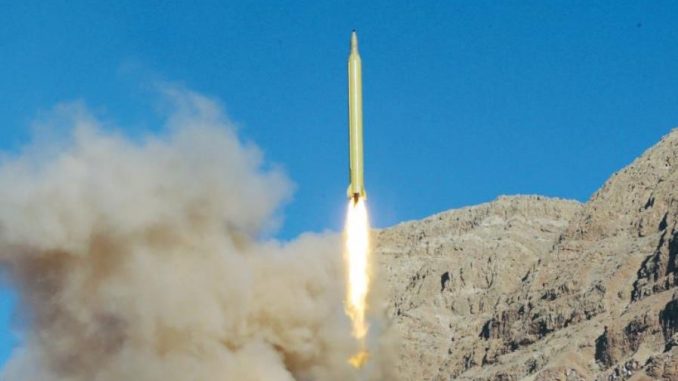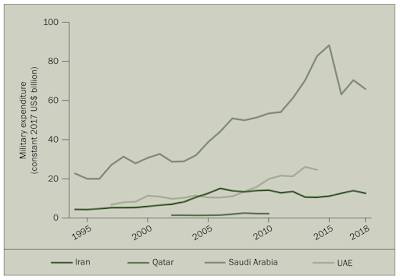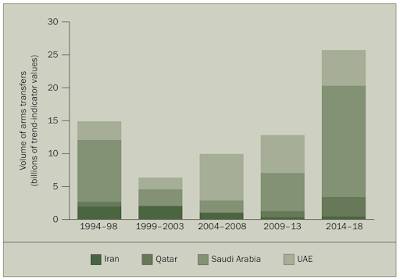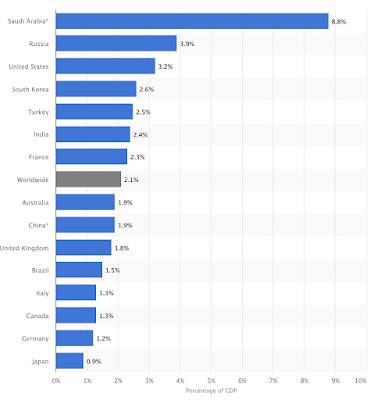
In a recent publication, the Stockholm International Peace Research Institute or SIPRI has released a fact sheet that looks at military spending by four of the key nations in the Middle East. Given that three of these nations are involved in conflicts in Syria, Yemen and Libya, and the fourth is the target of American-led sanctioning and threats resulting from its alleged involvement in recent attacks in Saudi Arabia and military operations in both Iraq and Syria, the research is particularly pertinent. In the first part of this posting, I want to look at military spending and arms imports by Iran, Saudi Arabia, Qatar and the United Arab Emirates (UAE) and focus on Saudi Arabia and its massive military spending. In the second part of this posting, I will focus on Iran and its military spending and imports.
Let's start by looking data which will help us set the stage for this posting. Here is a graphic that shows the trend in international transfers of major weapons going back to 1979:
According to SIPRI, United States arms exports grew by 29 percent between 2009 – 2013 and 2014 – 2018 with its share of total global arms exports rising from 30 to 36 percent over the same time period.
Now, let's look at what the SIPRI fact sheet says about arms spending by Saudi Arabia and its neighbours, Qatar, Iran and the UAE. Here is a graphic which shows the military spending in constant 2017 U.S. dollars of all four nations going back to 1994:
Asa you can see, there have been rapid growth in military spending by the United Arab Emirates and Saudi Arabia while military spending both Qatar and Iran have remained relatively constant in terms of 2017 dollars.
Here is a graphic that looks at the volume of arms transfers (i.e. imports) by the four nations broken down into five year periods:
Over the period between 1994 and 2018, Saudi Arabia's imports of arms have grown very significantly and at a far higher level than its counterparts. In contrast, Iranian imports of arms have declined significantly from the 1990s to the present.
Let's focus on Saudi Arabia. In 2018, Saudi Arabia's spending on its military was projected to be an estimated $67.6 billion, the third largest in the world and by a wide margin the highest in the Persian Gulf region. Saudi's military spending rose by 57 percent between 1996 and 1998, by 76 percent between 2003 and 2007 and by 63 percent between 2011 and 2015. Spending on Saudi Arabia's military dropped in lockstep with declining oil prices after 2015, dropping 28 percent in 2016, rising by 11 percent in 2017 and falling again by 6.5 percent in 2018.
Saudi Arabia's spending on its military was 8.8 percent of GDP, the highest in the world as shown on this graphic from Statista:
In 2018, Saudi spending as a percentage of GDP was down from a peak of 13 percent of GDP in 2015. On a per capita basis, Saudi spending on its military in 2018 was $2014, higher than all other nations in the world.
Now let's look at Saudi Arabia's arms imports. Here is a graphic showing the source nations for arms supplied to Saudi Arabia and the relative volume of those imports:
Let's look at two aspects of Saudi arms imports:
1.) Volume of Saudi Arabia's arms imports: arms imports rose markedly after 2009, rising by 192 percent between 2009 – 2013 and 2014 – 2018, making Saudi Arabia the world's largest arms importer.
2.) Source of Saudi Arabia's arms imports: the United States is, by a wide margin, Saudi Arabia's largest supplier of imported arms, a distinction that it has held since the 1990s. The United Kingdom and France have also been significant providers of arms to Saudi Arabia over the past two and a half decades.
Saudi Arabia's massive inventory of arms is wide ranging; the United States started delivering the first of 154 F-15SA combat aircraft in 2016, the United Kingdom delivered 72 Typhoon combat aircraft over the years between 2009 and 2017, Spain delivered six tanker aircraft between 2011 and 205 and between 2014 and 2018, the United States delivered 23 Patriot PAC-3 air and missile defense systems. In addition, over the period between 2014 and 2018, Austria, Canada, France, Georgia, South Africa and Turkey delivered over 4000 armoured vehicles and the United States delivers 338 tanks to bolster Saudi Arabia's ground forces.
Saudi Arabia's massive and ongoing investment in its military has resulted in the Saudi royal family having access to the largest inventory of technically advanced weaponry in the Middle East (excluding Israel since Saudi Arabia does not have access to an inventory of nuclear weapons). One has to wonder how the sales of American arms has affected the balance of power in the Middle East, particularly when these arms are being sold to a nation with a poor human rights record as shown in this quote from the United States Department of State 2018 Human Rights Report on Saudi Arabia:
"Human rights issues included unlawful killings; executions for nonviolent offenses; forced renditions; forced disappearances; and torture of prisoners and detainees by government agents. There were also reports of arbitrary arrest and detention; political prisoners; arbitrary interference with privacy; criminalization of libel, censorship, and site blocking; restrictions on freedoms of peaceful assembly, association, and movement; severe restrictions of religious freedom; citizens’ lack of ability and legal means to choose their government through free and fair elections; trafficking in persons; violence and official discrimination against women, although new women’s rights initiatives were implemented; criminalization of consensual same-sex sexual activity; and prohibition of trade unions."
In part two of this posting, I will look at military expenditures and arms transfer data for Iran, the world's current chief boogeyman.
 Click HERE to read more from this author.
Click HERE to read more from this author.
You can publish this article on your website as long as you provide a link back to this page.






Be the first to comment